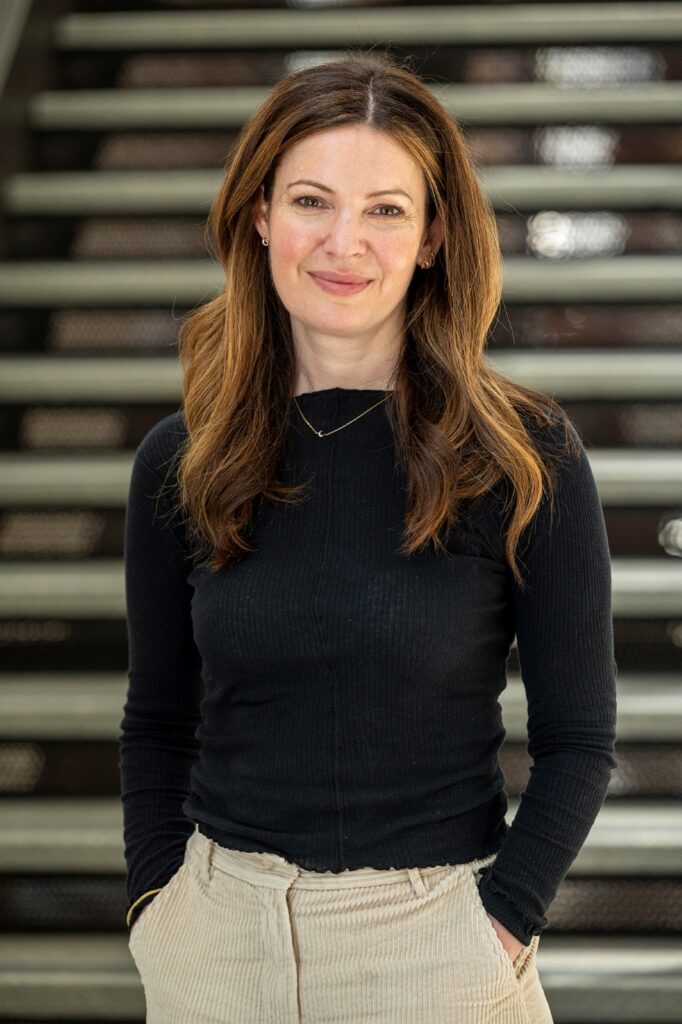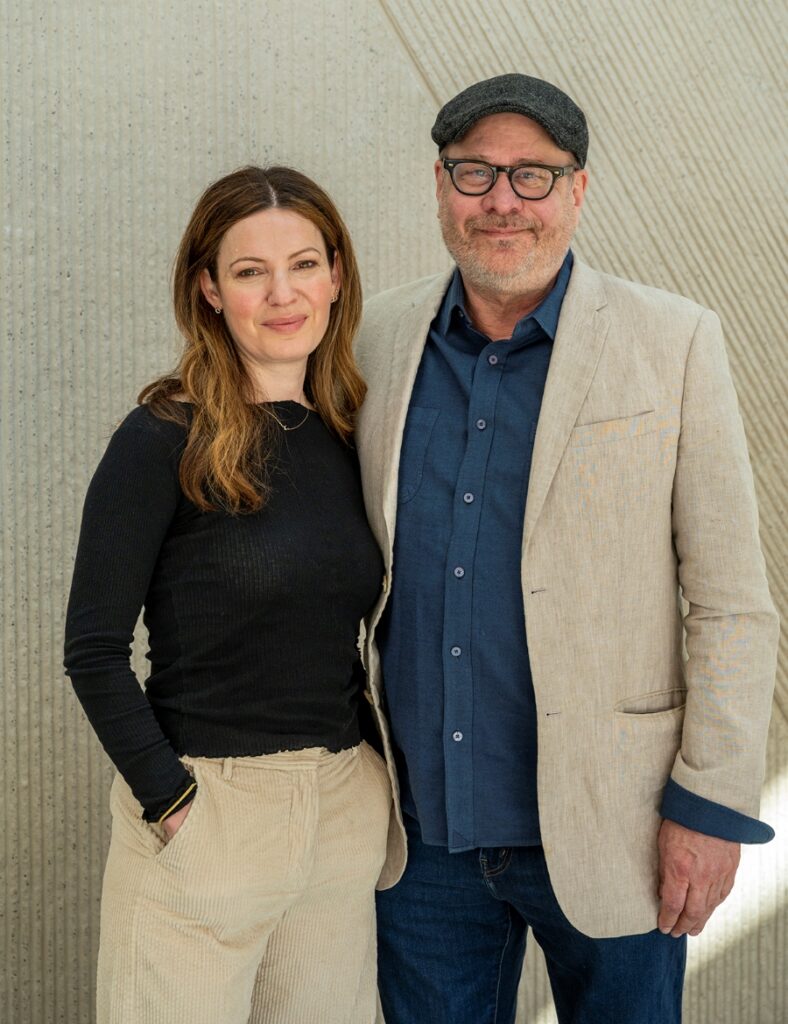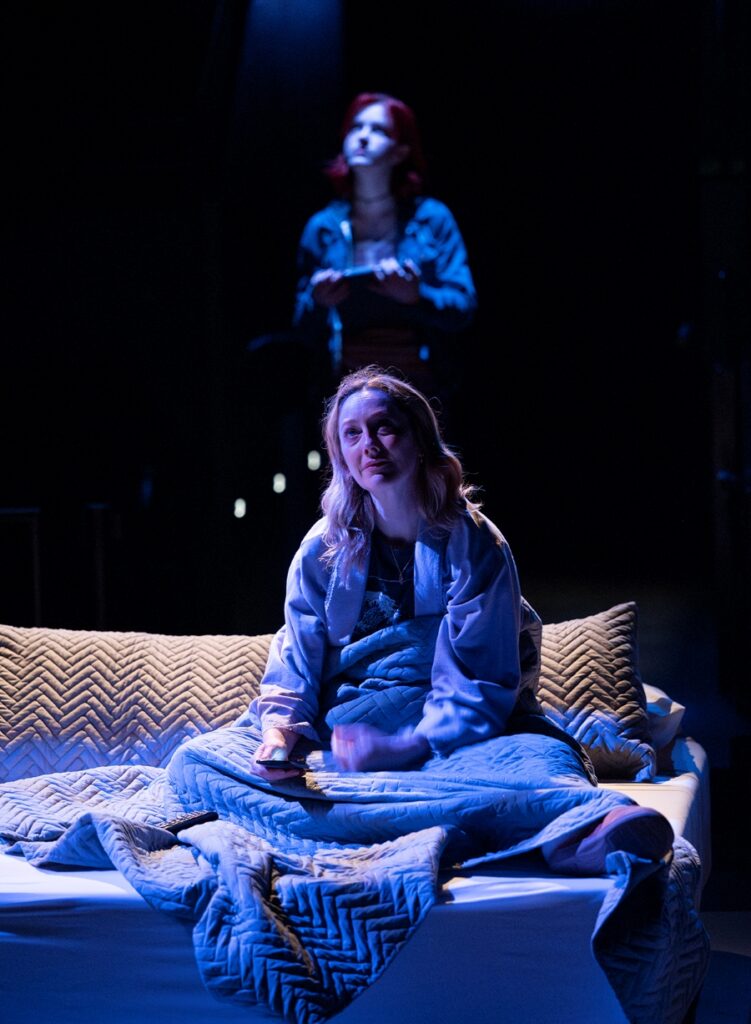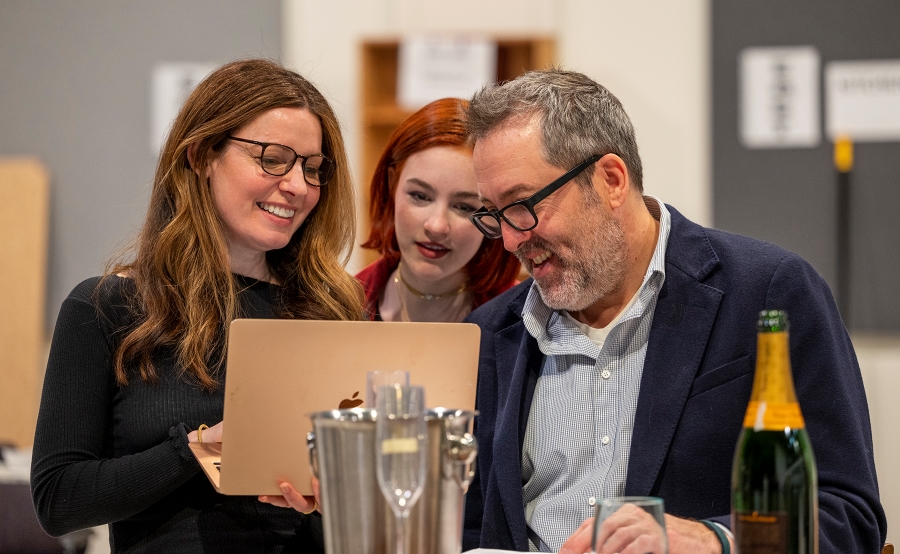Kate Arrington expected her playwriting debut to be something small. When the Steppenwolf Theatre Company ensemble member presented her first full-length play to then-artistic director Anna D. Shapiro, Arrington thought it might be headed toward something like a brief engagement at Steppenwolf’s 1700 Theater, a small cabaret-style, 80-seat space tucked behind the company’s bustling Front Bar. Four years and some development later, Arrington’s play is barreling toward opening night for a mainstage run (through July 23) in Steppenwolf’s beautiful 400-seat Ensemble Theater.
“It’s bigger than I expected,” Arrington confessed, sitting in the lobby of the now-two-year-old space. “But this is the place where I could have the emotional fortitude to go big and be okay with it failing, be okay with it not failing. I’ve grown up here since I did my first play in 2003.”

An ensemble member since 2007, Arrington is best known for her work on stage, performing in Steppenwolf’s productions of The Violet Hour, Hot L Baltimore, and East of Eden, among others. She’s graced Broadway’s stage in Richard Greenberg’s Our Mother’s Brief Affair and alongside Paul Rudd, Ed Asner, and Michael Shannon (Arrington’s husband, then making his Broadway debut) in Craig Wright’s Grace. (She also graced our cover when we published Lisa D’Amour’s play Detroit.) Now Arrington is stepping into the playwriting arena to tell a deeply personal story that both pays tribute to her late mother and ventures to break the mold of marriage stories audiences are used to seeing. And thankfully, Arrington has been able to do it alongside a group of trusted artists, collaborators, and ensemble members who have formed her longtime artistic home.
“I don’t think I’d be doing this play at a different theatre,” Arrington said. “I probably wouldn’t have written it if I didn’t know I had this home. I would definitely be just scared shitless in the rehearsal room.”
Of course, Steppenwolf is no stranger to actors-turned-playwrights. Tracy Letts and Bruce Norris immediately pop to mind. But Arrington’s opportunity still stands out. Yes, Steppenwolf has produced no less than seven of Norris’s plays, but there was a decade between the writing of his first play and his first Steppenwolf world premiere. And while Letts’s Man from Nebraska was the first of many of his plays to tread the ensemble’s boards when it hit the stage in 2003, that came a decade after Killer Joe introduced the world to Letts’s writing at a small theatre in Evanston, Ill.
Founding ensemble member Terry Kinney, who is directing Another Marriage, recalled Shapiro initially receiving a “rough gem” from Arrington and seeing the beauty in it. Arrington’s gift for dialogue, Kinney added, was immediately evident. Another theatre, he theorized, may have sent the script back, feeling it wasn’t finished enough.
“In so many aspects of this industry, artists are painted into a corner, asked to define themselves as this or that, or even worse, identify with a ‘type,'” said Steppenwolf co-artistic director Audrey Francis. “We believe the artists in our ensemble have a million pieces that make them who they are, and we are at our best when we create opportunities for them to work as courageously as possible.”
It’s a sentiment that goes back to former artistic director Martha Lavey, who advocated for ensemble members to explore those many pieces, the facets of being theatre artists that go beyond their acting. So, Kinney said, “What we did was start developing it. Having a family of artists, what excites us the most is the unfinished and unpolished.”

Arrington has always loved writing. She joked in a recent interview that she was able to write a few scenes in the past—good scenes, but still just individual scenes. And for a long time that had been okay. Some characters might reappear in different scenes over time, but she hadn’t found a full-length story that felt like something she needed to finish.
Then her mom, the English professor and writer Jean Arrington, received a devastating diagnosis. At first they thought she had Parkinson’s, but it became clear that she actually had a more fast-moving disease, multiple system atrophy, which damages nerve cells that control body functions.
“She went from one of those crazy people that go to, like, hot yoga every day ’cause if you go every day for two months, you get a free month, and she didn’t want to waste any of her free months,” Arrington said. “She was one of those people, and within a year she couldn’t walk and even couldn’t dress herself. I mean, she really needed significant help.”
It got to the point where, Arrington said, “I was scared to answer my cell phone,” for fear that it would be news of a fall her mother had taken. Then Jean’s ex-husband decided to move to New York City to help take care of her, despite their marriage having ended years prior.
“That was kind of the last chapter of what had been an incredibly long marriage that had a divorce in the middle, yet didn’t end,” Arrington said. “So I became interested in a story that stayed with the marriage beyond the point where we usually say it’s failed or succeeded.”
Through Another Marriage, Arrington explores what happens beyond the divorce, beyond what can easily be considered the end of a couple’s journey together. Once she started writing, Arrington said it took a little less than a year to write. In 2019, she did a reading with fellow ensemble members in her apartment before doing an official reading for Shapiro that fall. Days later, Arrington learned that Shapiro wanted to program it.
“It started at a place sort of contemplating the very beginning of losing my mom, and now I have lost my mom,” said Arrington, whose mother died in 2022. “It’s a different play now.”

Though Arrington wrote the play about her parents’ relationship, the characters in the show—Nick, played by ensemble member Ian Barford, and Sunny, played by film and television star Judy Greer—are written to be Arrington’s contemporaries. The play follows them from the spark of love in college through their marriage, and ultimately through their divorce and beyond. The story is framed through the eyes of Nick and Sunny’s daughter Jo (played by Nicole Scimeca), who mostly guides the audience as an outside observer to her parents’ story, a tablet in hand to write title cards for scenes and key moments in the relationship. (Ensemble member Caroline Neff rounds out the cast.) Even through its frame, Arrington’s story functions as a child’s loving tribute to the complex love and relationship (and growing pains) between her parents.
Arrington has had no shortage of talented peers at her side through her creation process, available to offer guidance and advice. During a residency at the New Harmony Project last year, she found herself alongside Ngozi Anyanwu and Lucy Thurber. Playwrights Richard Greenberg and Jessica Dickey, who both have had plays premiere at Steppenwolf, were there to field questions. And when Arrington posed the question, “What do I change?” it was the Pulitzer-winning Norris who responded by saying, “Nothing. You change nothing. You do the play you want to do.”
“That was an amazing thing to learn from,” Arrington said, acknowledging the fragile balancing act taking notes from others, telling the story she wants to tell, and making changes during rehearsals leading up to the production in a way that doesn’t undo the careful work of her actors. “As an actor, it’s interesting for me; I’m very hesitant to make changes, because I know it’s such a delicate process. You’re weaving, you have to connect every step you take. Everything has to make sense, every hesitation, every ellipsis. The writer part of me is like, ‘Let’s just try this.’ But I’m also like, no, you can’t do that to these people at this point in the process.”
At her side through years of this development has been Kinney, whom Arrington has known for some 20 years. Together they worked to craft Arrington’s profoundly personal story into something more universal. Kinney remarked that their friendship, and the nature of being fellow ensemble members, allowed him to be a bit less formal and more collaborative than he may otherwise have been with another playwright in the room. The banter between the two, Arrington remembered someone telling her, felt like dialogue straight from the play itself.

Greer, who is making her Steppenwolf debut, said she felt that partnership and trust in the rehearsal room. She said it was a true look at what “ensemble” means within Steppenwolf’s walls, within a theatre she’s dreamed of performing in since moving to Chicago at 18 to study at the Theatre School at DePaul University. Even beyond those involved in the production, Greer said she’s had ensemble members reach out, offering support or just to chat.
“It’s a very tight-knit group,” Greer said. “It feels like marrying into a family, you know?”
One tricky aspect, Kinney explained, is that there can be an impulse to mold a first-time playwright, nipping and tucking their script to fit a predetermined template, what may be seen as a “well-made play,” with a neat inciting incident, rising action, climax, and denouement. Arrington, Kinney recalled, wasn’t interested in this approach; it wasn’t how she wanted to tell her mother’s story, in part because that isn’t how things unfolded.

“Ultimately,” Kinney said, “I think she’s come up with something so singular that I’ve really had to sort of reboot my entire modus operandi as a director and try to accommodate the form.”
Ultimately Arrington crafted a sort of tale of two acts, with the first ending where you might expect the story of a relationship to end. The second act then explores what happens after, when the relationship continues in an unmistakably and irrevocably altered form. As they crafted the story, Kinney said, they explored a structure that, rather than building to one final climax, instead felt like a series of contractions, fluctuating between pain and relief.
“I got very interested in that structure as a storytelling tool,” Kinney said. “I had to relearn what I was trained to do in a way. I found that very, very challenging, and I also found it fulfilling, because my friend was teaching me something.”
It’s a structure that resulted in some moments of head scratching in the rehearsal room as they tried to figure out how it would all come together. But as previews began, Kinney said they found that audiences simply accepted the structure and the dynamic shift between the two acts. Previews also opened the door, Greer added, for them all to see just how funny Arrington’s script is, and the joy layered alongside its well of deep emotions.
Arrington wasn’t entirely sure what the life of Another Marriage might be after it closes in Chicago. Perhaps it will find another production or further development so she can experiment with bringing back aspects of the script that got lost along the way to this production. But she also teased that she’s writing another play. She’s clearly not soured on the experience of her first, a play she would have happily done in the 1700 Theater behind Front Bar. It’s hard to say what’ll be next, after all; as Arrington reminds herself and her audience, life continues on past our so-called “endings.”
“The first thing I wrote on the first page for myself—it’s not anything you’ll hear in the play—there’s a John Steinbeck quote that says, ‘Abandon the idea that you are ever going to finish,’” Arrington said. “He wrote it about writing, obviously. But it also applied to the relationship, to all relationships. They keep changing and they go on.”
Jerald Raymond Pierce (he/him) is the Chicago Editor for American Theatre. jpierce@tcg.org


